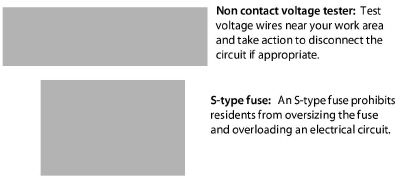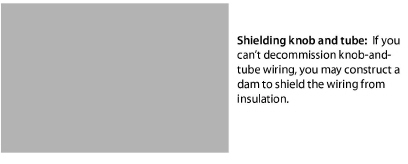
|
SWS Detail: 2.0100.1 Global Worker Safety, 2.0602 Electric Hazards |
Electrical fires and shocks are common and serious safety problems. Electrical safety is a basic housing need, requiring attention during weatherization and repair.
Observe the following specifications for electrical safety in weatherizing existing buildings.
ü When any weatherization, health, or safety procedure requires working with line-voltage power, a licensed electrician must do the procedure.
ü Whenever working around wiring, use a non-contact voltage tester to determine whether circuits are live. Turn circuits off at circuit breakers as appropriate.
ü Inspect wiring, fuses, and circuit breakers to verify that wiring isn’t overloaded. Maximum ampacity for 14-gauge wire is 15 amps and for 12-gauge wire is 20 amps.
ü Confirm that all wire splices are enclosed in electrical junction boxes. If you plan to cover a junction box with insulation, attach a flag to mark its location.
ü Don’t allow metal insulation shields to contact wiring.
ü Verify that the electrical system is grounded to either a ground rod or to a metallic water pipe with an uninterrupted electrical connection to the ground.
ü If installing insulation, install S-type fuses where appropriate to prevent occupants from installing oversized fuses.
ü When you doubt the safety of a building’s electrical system, use a generator to power insulation blowers and other large power tools.

1.8.1 Decommissioning Knob-and-Tube Wiring
Decommission knob-and-tube wiring before or during weatherization if possible. Try to convince your clients or their landlords to replace knob-and-tube wiring with their own funds.

Use a non-contact voltage tester to determine whether the knob-and-tube wiring is live. If you’re unsure about whether the wiring is still live, schedule an inspection by an electrician.
If the knob-and-tube wiring in an attic is live, ask an electrician and/or an electrical inspector to determine whether the attic wiring can be decommissioned and replaced with non-metallic (NM) sheathed electrical cable. Depending on the situation, the electrician may choose one of these two options.
1. Terminate the existing attic knob-and-tube wiring, and connect the new NM circuit directly to the main service box.
2. Install a flagged junction box in the attic to connect the knob-and-tube riser to new NM cable in the attic.
Consider installing a hard-wired CO/smoke detector in a common area near the bedrooms on the new circuit.
1.8.2 Constructing Shielding for Knob-and-Tube Wiring
|
SWS Detail: 2.0601.1 Knob and Tube Wiring, 4.1001.2 Knob and Tube Wiring |
You may install attic insulation up to the bottom of knob-and-tube wiring, but never cover knob-and-tube wiring with insulation that covers the wires.

ü Construct structural dam to maintain a 3-inch clearance between attic insulation and knob-and-tube wiring. Don’t cover the knob-and-tube wiring.